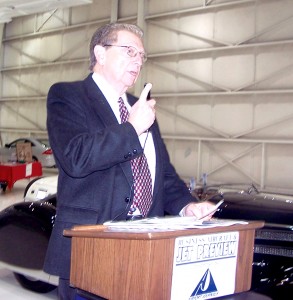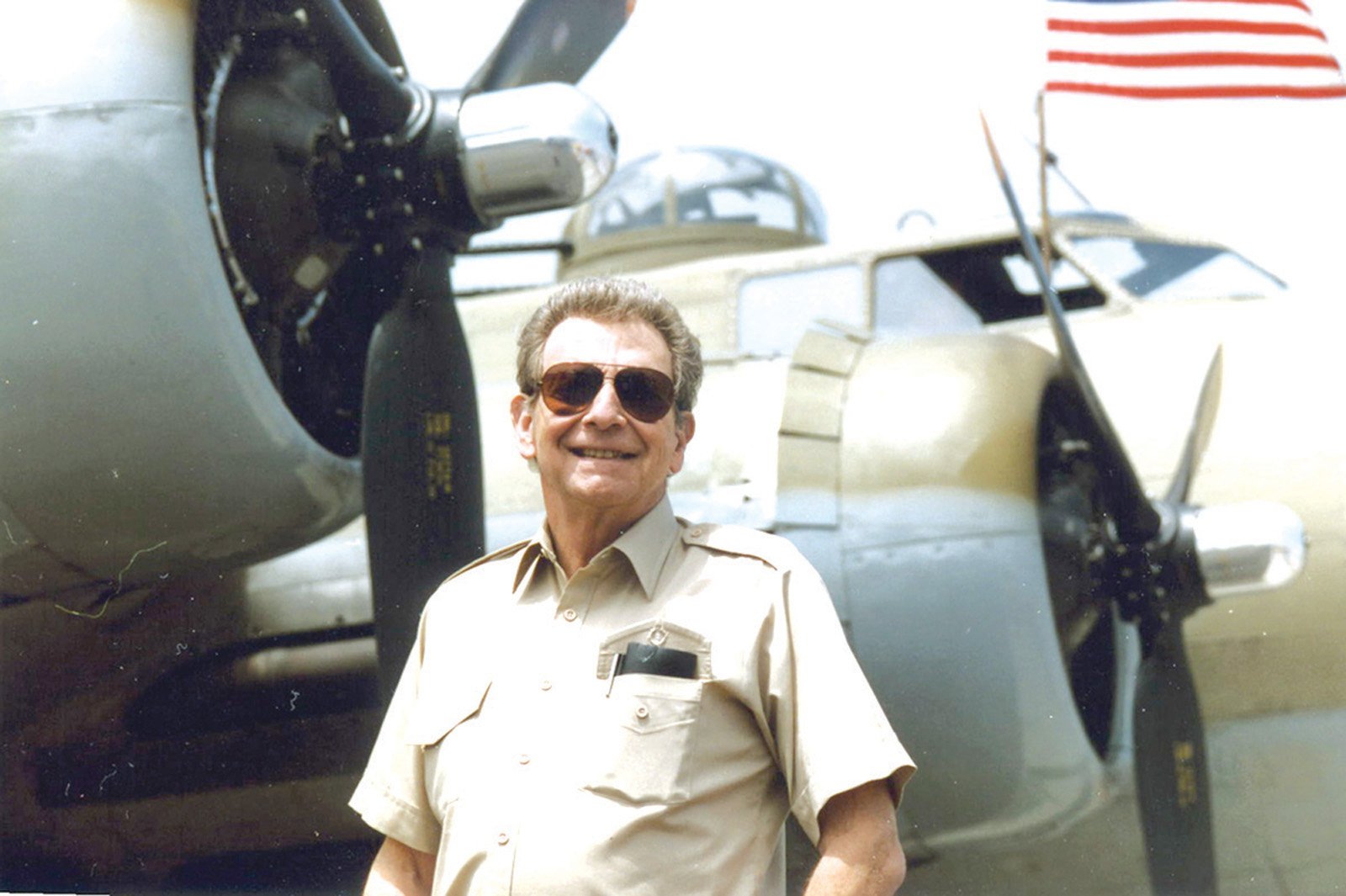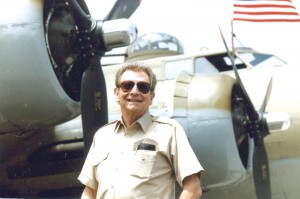|
By Clayton Moore
Hal Fishman was many things to many people, be it trusted journalist, record-breaking aviator or the West Coast’s favorite anchorman. The deeply respected newsman for KTLA Television was also the longest-running news anchor in the United States, but his time ran out on Aug. 7. The anchor’s last broadcast occurred on July 30, just eight days before his death from complications related to cancer. On the evening of Thursday, Aug. 2, KTLA reported that Fishman had been hospitalized after collapsing at his home the previous day. Fishman was being treated for a serious infection when his doctors discovered that he had colon cancer, which had spread to his liver. He died at home with his family by his side. He is survived by his wife, Nolie, and his son David, who recently completed his doctorate at the London School of Economics. The following morning, KTLA broadcast the news of its anchor’s death. The station interrupted its regular news schedule to celebrate Fishman’s life during their morning and evening newscasts. Within hours, thousands of tributes appeared on the station’s website from loyal viewers and other citizens who simply trusted Hal Fishman to tell them the truth. “The Flying Professor” Fishman was born in Brooklyn on Aug. 25, 1931. His career started at UCLA, where he received his M.A. in political science in 1956, and was well on his way to completing his doctorate. For two years, he even taught the subject at California State University in Los Angeles. In 1960, on the eve of the Democratic National Convention that would nominate John F. Kennedy as president, a local station invited the 28-year-old Fishman to teach an on-air course called “American Political Parties in Politics.” |
“I had no desire at all to go on television,” Fishman said. “I loved teaching, but I got talked into it. I said to myself, ‘You can reach more people in one broadcast than you can teach in a lifetime.'”

Hal Fishman’s television interviews were famous for integrating his interests in aviation and journalism. This photo, shot in the early 1970s, shows him interviewing flight instructor Chuck Miller in front of Fishman’s Piper Comanche 250.
Throughout his life, he credited his success far more to his educational background than any natural broadcasting ability. Great ratings for the program led to a nightly segment and from there, an anchor position. He’d been on the air continuously since June 20, 1960, and had anchored KTLA’s 10 p.m. newscast, “KTLA Prime News,” since 1975.
Fishman came from a generation more concerned with journalistic integrity than aesthetics or ratings, and his sense of responsibility to his viewers helped him retain credibility in the modern age of media saturation.
“I’ve never considered myself a television personality,” Fishman said. “When I go on TV, my job is to teach. I’ve always considered the role of a newscaster to be the conduit for information for the public. You have to respect the intelligence of your audience. The television camera doesn’t lie and you are a guest in peoples’ homes every night of the week.”
Fishman covered breaking news in Los Angeles and around the world. He held vigil at the hospital after an assassin felled Robert Kennedy at the Ambassador Hotel in Los Angeles. He reported on the Watts riots, Vietnam War protests, earthquakes, fires and the police pursuit of a white Ford Bronco with O.J. Simpson inside. He would often lecture to journalism students on the importance of context in reporting.
“I feel that the news is as important in a democratic society as teaching or medicine or the legal profession,” Fishman said. “I tell students that are going into journalism that it’s good to know the mechanics, but to also study political science and history, so that when they give their newscasts, they understand what they’re reading.”
Fishman covered the biggest story of his career in March 1991, when a home video was brought into the station showing LAPD police officers repeatedly beating a man with their batons. The station bought the tape for $500, purchasing one of the most controversial images ever aired: the arrest of Rodney King. As the managing editor, Fishman knew he had a volatile decision to make. He confirmed with LAPD sources that the incident had taken place and gave his news team the order that changed Los Angeles forever: “Run it.”
That decision, enflamed by the subsequent acquittal of the four police officers who were charged with police brutality, led to the April 1992 riots that nearly destroyed sections of south-central Los Angeles. More than 50 people were killed during the riots and more than 600 buildings were burned to the ground. Property damage from the riots cost an estimated $1 billion.

“I remember Hal giving me the news when I first came to California in 1968,” said California Governor Arnold Schwarzenegger (right), who paid tribute to the late journalist by dubbing him “an icon” of California.
“The decision to run that tape was solely my decision; I had to make that choice in under a half hour,” Fishman said. “It’s a classic case and a lot of journalism classes now use that incident as an example. I had that little tape in my hand; I knew the impact was going to be tremendous if I put it on the air. Many professors raise the question, ‘If you knew what was going to happen, would you still run that tape?’ My answer is yes. I would run it.”
Adventures in aviation
Fishman was a dedicated, deeply passionate pilot who counted other pilots among his closest friends. He spoke of the camaraderie in aviation during an interview with Airport Journals in May 2005.
“We’re all part of the flying club,” he said. “I think the desire to fly is innate. I think it’s born in you; you have it or you don’t. I’ve always believed that people can learn to fly, but you can’t learn to love it. It’s a unique club, and I’ve never seen anything like it. There’s a real admiration between pilots, whether they’re general aviation pilots or fighter jocks. It binds pilots together and it really brings out the best in them.”
Fishman fell in love with airplanes as a child.
“It’s the freedom and beauty of flying,” he said. “When I was a little boy, I can remember my first flight at about 5 years old. I nagged my parents to go on a little private airplane at Floyd Bennett Field in Brooklyn. I used to go down there and watch the airplanes.”
Fishman got his license in 1964.
“In 1969, I started setting records,” he said.
Until his death, Fishman remained a devoted aviator who held 13 world records for speed and altitude. He traveled around the world twice with famed pilot Clay Lacy, taking part in several of Lacy’s world speed record flights, and counted racing legend Bob Hoover among his closest allies.
Another friend was fellow aviator Barry Schiff, with whom Fishman shared the Fédération Aéronautique Internationale’s Louis Blériot Medal in 1969. They co-authored two aviation novels in the 1970s. “The Vatican Target” nearly got them arrested.
“It’s a funny story,” Schiff recalled. “The first novel involves hijacking an airplane carrying the pope. We were sitting in a restaurant discussing the logistics of hijacking this plane and I guess we got a little bit loud. Someone in the next booth could easily overhear us. The next thing we knew, two cops were standing at our table wanting to know what we were planning to do to the pope. Someone had called the police and reported us. Once we explained what we were doing, it turned into a big joke, but it wasn’t too funny at the time.”

Hal Fishman presented an award to his friend and fellow aviator Clay Lacy during the 2005 Van Nuys Business Aircraft & Jet Preview.
From time to time, work would put Fishman’s piloting skills to the test. His first major assignment was covering the Watts riots in 1965, which contributed to the station winning both an Emmy and a Peabody Award for its news coverage.
He was on the scene during his station’s pioneering use of live helicopter coverage, an uncommon innovation at the time.
“During the riots, I can recall being down at the police command center right in the middle of the civil unrest,” he remembered. “The police asked us to fly to an intersection where they had a report of an officer down but had no idea if it was a trap. Everyone has a helicopter now, but in those days, we were the only ones.”
They used helicopters for covering news in the city and environs, but used his plane when something bigger was happening. He owned three planes over the years: a Piper Comanche 250, a V-tail Bonanza and a B36TC Bonanza. He covered major news stories in all of them.
“I used the Piper Comanche when there was a big oil spill off the coast of Santa Barbara,” he said in 2005. “I’d fly up there and do a daily report on the cleanup and the spill’s effect on the beaches. When Mount St. Helens erupted in the Northwest, I flew my V-tail Bonanza to Washington and circled the volcano, shooting right down into the crater. I’ve covered forest fires up in the Sierra Nevada Mountains and anything else that occurs to me to shoot from the air.”
One of the more unusual stories Fishman covered with his plane involved a fishing trawler spotted 50 miles off the coast of Los Angeles in the late 1980s.
“It was rumored that a Soviet spy ship was off the coast,” Schiff said. “Hal was determined to find it. He took his trusty Bolex 16mm movie camera and located the trawler; it was bristling with antennae and had Russian markings on the side. He circled around taking pictures for an hour. He said it was somewhat amusing circling around this thing at low altitude while all these Soviet sailors stood around wondering what he was doing. That’s how Hal ended up showing what a Soviet spy ship looked like on the nightly news.”
In the days following Fishman’s death, his colleagues recalled his passion for accurately reporting on aviation.
“No matter who was assigned to write a story about a plane crash or the introduction of a new plane, the story was never written the right way,” said Rich Goldner, interim news director at KTLA. “Hal had to sink his teeth into it and put his touch on it.”
Fishman traveled to the Mojave Desert to interview Dick Rutan and Jeana Yeager, prior to their record-setting journey in the Voyager in 1986.
“They were just beginning to work on the plane; Hal was interested in them way before they broke the record,” recalled KFWB-AM reporter Steve Lentz. “When they set the record, Hal liked that quite a bit.”
Lentz also remembered the mid-air crash of an Aeromexico plane and a smaller aircraft on a Labor Day weekend.
“Hal drove to the station immediately and started explaining what happened,” Lentz said. “He was there all afternoon until news trucks got to the crash site. On any airplane story, he wanted to be number one.”
Fishman also managed to find time for an acting sideline in dozens of Hollywood movies, usually playing himself.
“It wasn’t a conscious effort,” Fishman said of his acting career. “Producers call and ask if I’ll be in their movie. They come in with the script, I do my one take and out they go.”
His first role was in the action thriller “Black Sunday” in 1977. He can also be seen in “Crocodile Dundee in Los Angeles,” “National Security,” and “Spider-Man 3.” He appeared in the aviation documentary “One Six Right,” recalling how he found his own inspiration at Van Nuys Airport.
His fellow journalists lauded Fishman repeatedly. His awards included an Emmy Award, a Golden Mike, and even a star on the Hollywood Walk of Fame, bestowed in 1991. In 2002, the Associated Press Television-Radio Association presented him with its first Lifetime Achievement Award and named him Best News Anchor for the third consecutive year. He has also received the Governor’s Award from the Los Angeles Academy of Television Arts and Sciences and the Outstanding Broadcast Journalism Award from the Society of Professional Journalists. In 2000, KTLA named its newsroom the “Hal Fishman Newsroom” in his honor.
The popular news station had recently celebrated his career, on July 31, with a gala attended by prominent city dignitaries including Mayor Antonio Villaraigosa. The presentation included congratulations from “Tonight Show” host Jay Leno and California Governor Arnold Schwarzenegger.
It is essential that our news be objective, our news be credible, our news be knowledgeable,” Fishman said in a fiery speech at the gala. “You can’t just hire people to do the news who don’t have the experience in a market like this one. It is essential that we have the experience and the maturity to make rapid decisions.”
Schwarzenegger said that while Fishman won many awards in his tenure as anchor, perhaps most importantly, he won the respect and trust of news viewers throughout California.
“Many followed him through his prestigious 47-year career,” he said. “Hal will forever remain an icon in California history.”
For more information, video and remembrances of Hal Fishman’s life and career, visit KTLA at [http://ktla.trb.com.












